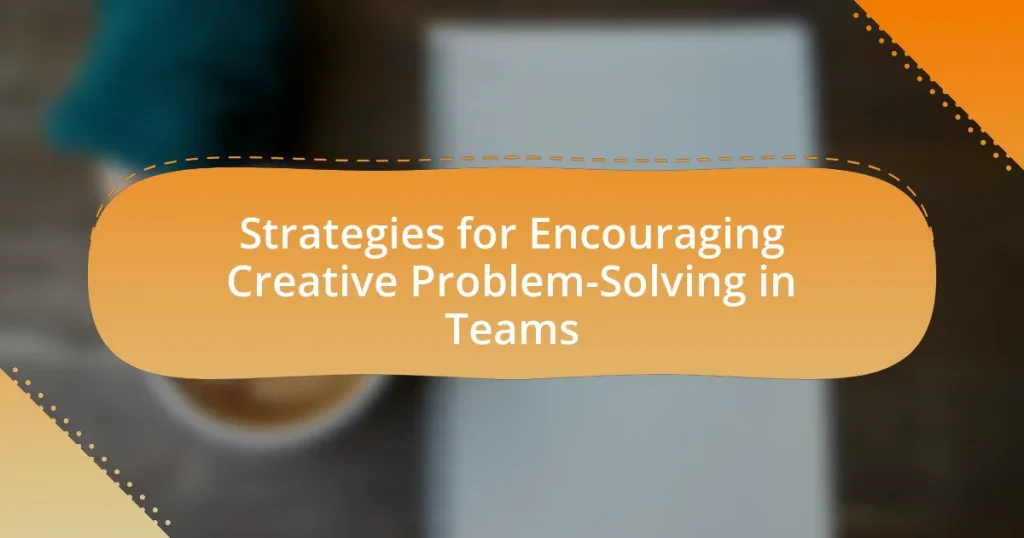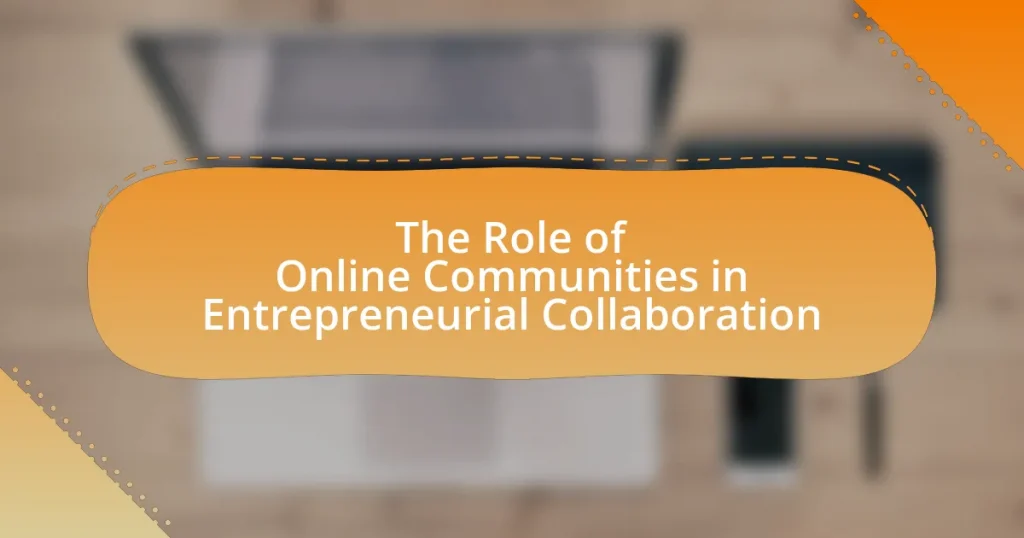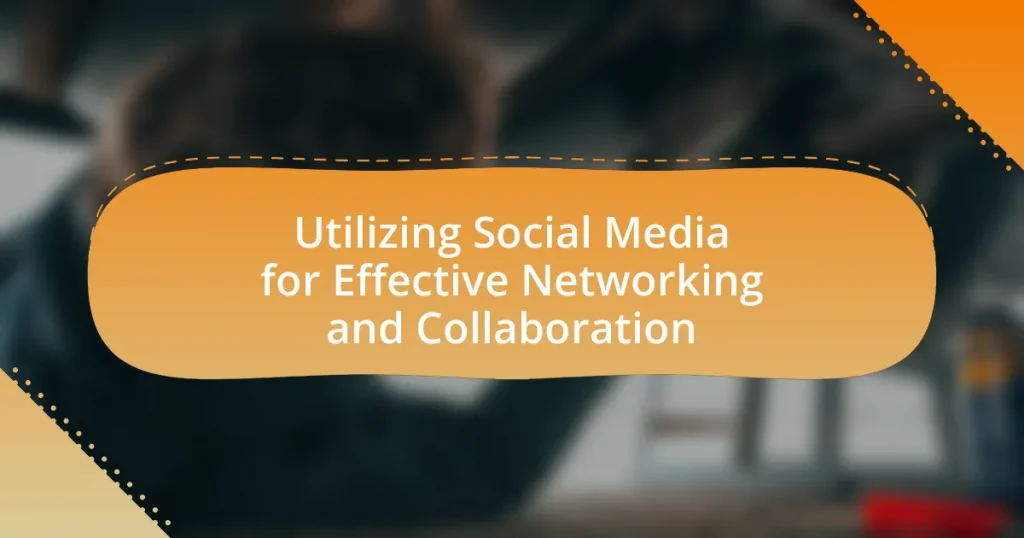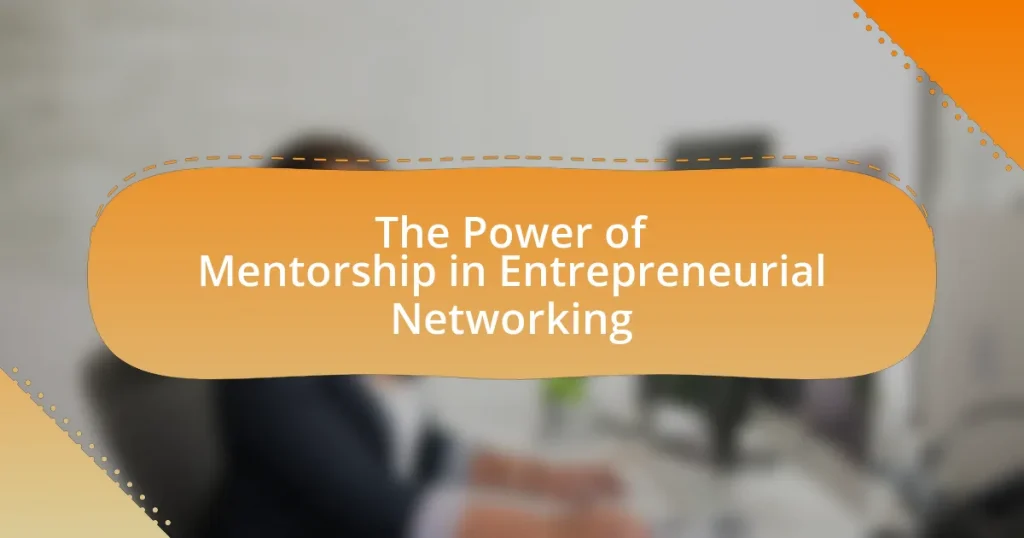The article focuses on strategies for encouraging creative problem-solving in teams, emphasizing the importance of fostering an open environment, promoting diverse perspectives, and utilizing structured brainstorming techniques. It explores how team dynamics, individual roles, and environmental factors influence creativity, highlighting the significance of psychological safety and effective communication. Additionally, the article discusses methods for stimulating creative thinking, the impact of organizational culture, and the role of leadership in nurturing innovation. It also addresses common challenges teams face in creative problem-solving and offers practical tips and tools to enhance collaborative efforts and sustain creativity over time.
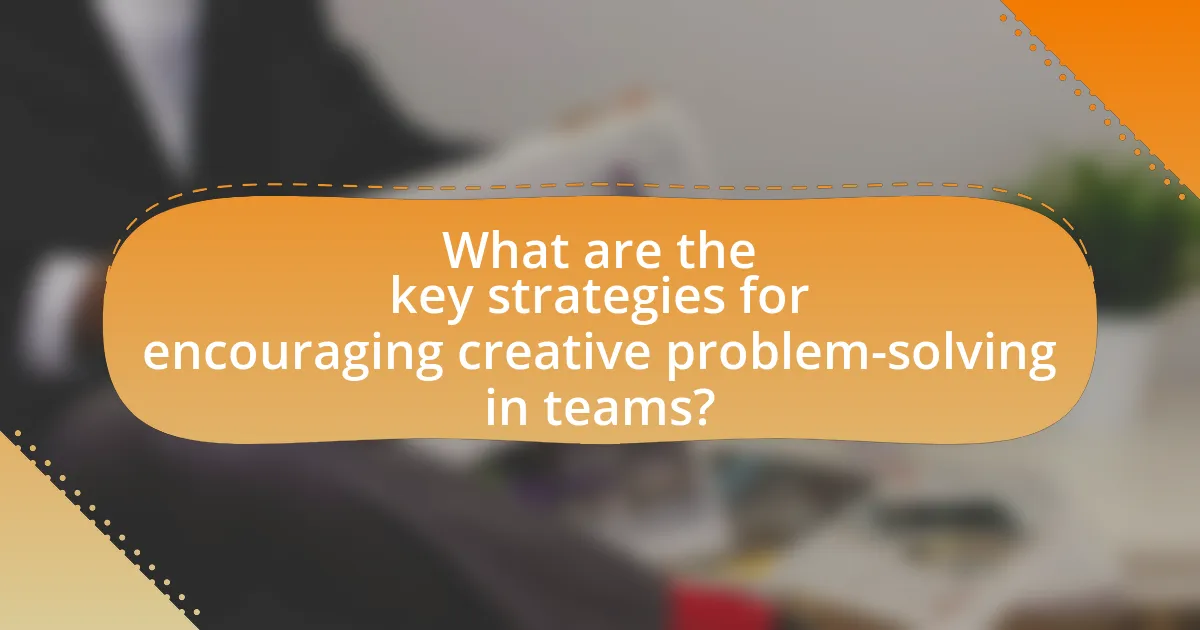
What are the key strategies for encouraging creative problem-solving in teams?
Key strategies for encouraging creative problem-solving in teams include fostering an open environment, promoting diverse perspectives, and utilizing structured brainstorming techniques. An open environment allows team members to share ideas without fear of criticism, which has been shown to enhance creativity and innovation. Promoting diverse perspectives brings together varied experiences and viewpoints, leading to more comprehensive solutions; research indicates that diverse teams outperform homogeneous ones in problem-solving tasks. Structured brainstorming techniques, such as the “Six Thinking Hats” method, guide teams in exploring different angles of a problem systematically, increasing the likelihood of generating innovative solutions.
How can team dynamics influence creative problem-solving?
Team dynamics significantly influence creative problem-solving by shaping communication, collaboration, and trust among team members. Effective team dynamics foster an environment where diverse perspectives are valued, leading to innovative solutions. Research indicates that teams with high psychological safety, where members feel safe to express ideas without fear of judgment, are more likely to engage in creative problem-solving. For instance, a study by Edmondson (1999) in the Harvard Business Review found that teams with strong interpersonal relationships and open communication channels generate more creative ideas and solutions. Thus, positive team dynamics enhance the overall creative capacity of the group.
What roles do team members play in fostering creativity?
Team members play crucial roles in fostering creativity by contributing diverse perspectives, facilitating open communication, and encouraging risk-taking. Diverse perspectives enhance problem-solving by introducing varied ideas and approaches, which can lead to innovative solutions. Open communication allows team members to share their thoughts freely, creating an environment where creativity can thrive. Encouraging risk-taking helps individuals feel safe to express unconventional ideas without fear of criticism, which is essential for creative exploration. Research indicates that teams with a culture of psychological safety, where members feel secure to take risks, are more likely to generate creative outcomes.
How does diversity within a team enhance problem-solving capabilities?
Diversity within a team enhances problem-solving capabilities by bringing together varied perspectives, experiences, and skills that contribute to more innovative solutions. Teams composed of individuals from different backgrounds are more likely to approach problems from multiple angles, leading to a broader range of ideas and creative solutions. Research by the Harvard Business Review indicates that diverse teams are 35% more likely to outperform their homogeneous counterparts in terms of problem-solving effectiveness. This is because diverse teams can leverage their unique insights to identify potential pitfalls and opportunities that a more uniform group might overlook.
What environmental factors contribute to creative problem-solving?
Environmental factors that contribute to creative problem-solving include physical space, social dynamics, and organizational culture. A conducive physical environment, such as open spaces with natural light and collaborative areas, enhances creativity by reducing stress and promoting interaction among team members. Social dynamics, including diverse team composition and supportive relationships, foster an atmosphere where ideas can be freely exchanged and developed. Additionally, an organizational culture that encourages risk-taking and values innovation leads to higher levels of creative output, as evidenced by studies showing that companies prioritizing creativity in their culture report better problem-solving capabilities and overall performance.
How does physical workspace design impact creativity?
Physical workspace design significantly impacts creativity by influencing employee behavior, collaboration, and overall mood. Research indicates that open spaces, natural light, and flexible layouts foster communication and idea exchange, which are crucial for creative processes. A study published in the Journal of Environmental Psychology found that environments with natural elements, such as plants and sunlight, can enhance cognitive function and creativity by up to 15%. Additionally, spaces that allow for movement and informal interactions encourage spontaneous brainstorming, leading to innovative solutions. Thus, thoughtful workspace design directly correlates with enhanced creative output among teams.
What role does organizational culture play in encouraging innovation?
Organizational culture plays a crucial role in encouraging innovation by fostering an environment that supports creativity and risk-taking. A culture that values open communication, collaboration, and diversity of thought enables employees to share ideas freely and experiment without fear of failure. Research by the Harvard Business Review indicates that organizations with a strong innovation culture, characterized by supportive leadership and a focus on learning, are 3.5 times more likely to be among the top innovators in their industry. This demonstrates that a positive organizational culture directly correlates with increased innovative output and problem-solving capabilities within teams.
What techniques can be employed to stimulate creative thinking?
Techniques to stimulate creative thinking include brainstorming, mind mapping, and role-playing. Brainstorming encourages the generation of a wide range of ideas without immediate criticism, fostering an open environment for creativity. Mind mapping visually organizes thoughts and concepts, allowing individuals to explore connections and generate new ideas. Role-playing enables team members to step into different perspectives, enhancing empathy and sparking innovative solutions. Research by Osborn in 1953 established brainstorming as a foundational technique for idea generation, demonstrating its effectiveness in group settings.
How can brainstorming sessions be structured for maximum effectiveness?
To structure brainstorming sessions for maximum effectiveness, implement a clear framework that includes defined objectives, diverse participant selection, and time constraints. Establishing specific goals ensures that the session remains focused and productive, while including participants from various backgrounds fosters a wider range of ideas. Research indicates that diverse teams generate more innovative solutions, as evidenced by a study published in the Harvard Business Review, which found that diverse groups outperform homogeneous ones in problem-solving tasks. Additionally, setting time limits encourages participants to think quickly and creatively, preventing over-analysis and promoting spontaneity in idea generation.
What are the benefits of using creative thinking frameworks?
Using creative thinking frameworks enhances problem-solving by providing structured approaches that stimulate innovative ideas. These frameworks, such as brainstorming, mind mapping, and design thinking, encourage collaboration and diverse perspectives, leading to more comprehensive solutions. Research indicates that teams employing structured creative processes can generate 20% more ideas compared to unstructured sessions, as shown in a study by the University of Illinois. Additionally, frameworks help in organizing thoughts, reducing cognitive overload, and fostering an environment where team members feel safe to express unconventional ideas, ultimately driving better outcomes in team projects.
How can feedback and iteration improve creative problem-solving?
Feedback and iteration enhance creative problem-solving by fostering continuous improvement and refining ideas through collaborative input. When teams receive feedback, they can identify strengths and weaknesses in their approaches, allowing for targeted adjustments that lead to more effective solutions. Iteration, the process of repeatedly refining ideas based on feedback, encourages experimentation and exploration of multiple perspectives, which is crucial in creative endeavors. Research indicates that teams that engage in iterative processes are more likely to produce innovative outcomes, as they can adapt and evolve their strategies in response to real-time insights and critiques. This dynamic interaction not only improves the quality of solutions but also strengthens team cohesion and collective creativity.
What methods can be used to provide constructive feedback?
Constructive feedback can be provided through methods such as the “sandwich” technique, specific examples, and active listening. The “sandwich” technique involves presenting positive feedback, followed by constructive criticism, and concluding with more positive remarks, which helps to soften the impact of criticism. Providing specific examples of behaviors or outcomes allows the recipient to understand exactly what needs improvement, making the feedback actionable. Active listening ensures that the feedback process is a two-way conversation, allowing the recipient to express their thoughts and feelings, which can lead to a more productive dialogue. These methods are effective as they promote a supportive environment that encourages growth and improvement.
How does the iterative process enhance team creativity?
The iterative process enhances team creativity by promoting continuous feedback and refinement of ideas. This cyclical approach allows team members to build upon each other’s contributions, leading to more innovative solutions. Research indicates that iterative methods, such as design thinking, encourage experimentation and risk-taking, which are crucial for creative breakthroughs. For instance, a study published in the Journal of Creative Behavior found that teams using iterative processes generated 30% more creative ideas compared to those that did not. This evidence supports the notion that iterative cycles foster an environment where creativity can thrive through collaboration and ongoing improvement.
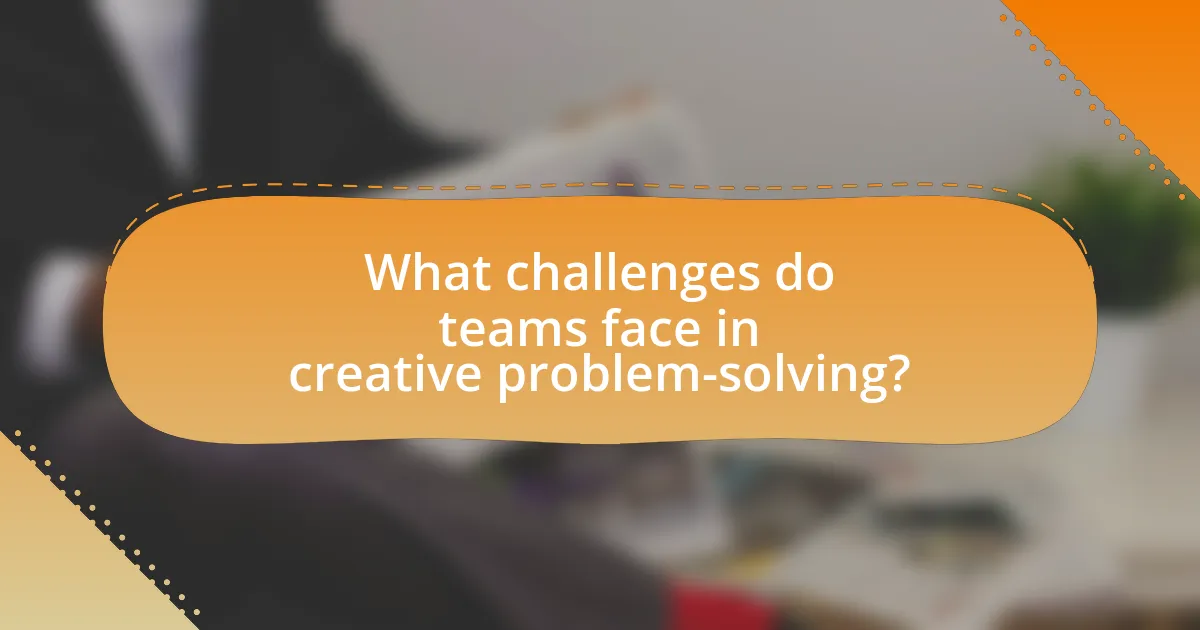
What challenges do teams face in creative problem-solving?
Teams face several challenges in creative problem-solving, including communication barriers, differing perspectives, and fear of failure. Communication barriers can lead to misunderstandings and hinder the sharing of ideas, which is crucial for creativity. Differing perspectives, while potentially beneficial, can also result in conflict and difficulty in reaching consensus. Fear of failure can stifle innovation, as team members may hesitate to propose unconventional ideas due to concerns about judgment or repercussions. These challenges can impede the effectiveness of creative problem-solving efforts within teams.
What common barriers hinder creativity in teams?
Common barriers that hinder creativity in teams include fear of failure, lack of psychological safety, and rigid organizational structures. Fear of failure can stifle innovative ideas, as team members may hesitate to share unconventional thoughts due to concerns about negative repercussions. Lack of psychological safety prevents open communication, making individuals reluctant to express their ideas or challenge the status quo. Rigid organizational structures can limit flexibility and discourage experimentation, which are essential for creative problem-solving. Research by Google on team effectiveness highlights that psychological safety is a critical factor for fostering creativity, as teams with high psychological safety are more likely to engage in risk-taking and idea sharing.
How can fear of failure impact team creativity?
Fear of failure can significantly hinder team creativity by stifling innovation and discouraging risk-taking. When team members are preoccupied with the possibility of failing, they may avoid proposing bold ideas or experimenting with unconventional solutions. This reluctance can lead to a culture of conformity, where safe, incremental changes are favored over creative breakthroughs. Research indicates that environments characterized by high fear of failure often result in lower levels of collaboration and open communication, which are essential for fostering creativity. For instance, a study published in the Journal of Business Research found that teams with a supportive atmosphere that encourages risk-taking are more likely to generate innovative ideas compared to those that fear negative consequences for failure.
What role does time pressure play in creative problem-solving?
Time pressure can enhance creative problem-solving by prompting individuals to think more quickly and generate innovative solutions under constraints. Research indicates that moderate time pressure can lead to increased focus and a sense of urgency, which often stimulates creative thinking. For instance, a study published in the Journal of Experimental Psychology found that participants under time constraints produced more original ideas compared to those with ample time, suggesting that the pressure can foster divergent thinking. Thus, while excessive time pressure may hinder performance, a balanced level can effectively encourage creativity in problem-solving contexts.
How can teams overcome these challenges?
Teams can overcome challenges in creative problem-solving by fostering an open communication environment. Encouraging team members to share ideas without fear of criticism leads to a more collaborative atmosphere, which is essential for innovation. Research indicates that teams with high psychological safety are 12 times more likely to engage in creative problem-solving (Edmondson, 2019). Additionally, implementing structured brainstorming sessions can help guide discussions and ensure that all voices are heard, further enhancing the team’s ability to generate diverse solutions.
What strategies can be implemented to reduce fear of failure?
To reduce fear of failure, organizations can implement strategies such as fostering a supportive environment, encouraging open communication, and promoting a growth mindset. A supportive environment allows team members to express concerns without judgment, which can alleviate anxiety associated with failure. Open communication encourages sharing of ideas and experiences, reinforcing that failure is a part of the learning process. Promoting a growth mindset, as supported by research from Carol Dweck, emphasizes that abilities can be developed through dedication and hard work, which can significantly reduce the fear of failure by framing it as an opportunity for growth rather than a setback.
How can time management techniques support creative processes?
Time management techniques can enhance creative processes by providing structure and reducing stress, which allows individuals to focus on innovative thinking. Techniques such as the Pomodoro Technique, which involves working in focused bursts followed by short breaks, have been shown to improve concentration and creativity by preventing burnout and maintaining mental freshness. Research indicates that structured time allocation can lead to higher productivity and better idea generation, as individuals are less likely to feel overwhelmed and more likely to engage in deep work. Additionally, setting specific time limits for brainstorming sessions can encourage teams to generate a greater number of ideas in a shorter period, fostering a more dynamic creative environment.

What are the best practices for sustaining creative problem-solving in teams?
The best practices for sustaining creative problem-solving in teams include fostering an open environment, encouraging diverse perspectives, and implementing structured brainstorming sessions. An open environment allows team members to share ideas without fear of criticism, which is essential for creativity. Encouraging diverse perspectives brings in varied experiences and viewpoints, enhancing the problem-solving process. Structured brainstorming sessions, such as using techniques like mind mapping or the Six Thinking Hats method, provide a framework that can guide discussions and ensure all voices are heard. Research indicates that teams that embrace these practices are more innovative and effective in generating solutions, as evidenced by a study published in the Journal of Creative Behavior, which found that diverse teams outperform homogeneous teams in creative tasks.
How can ongoing training and development foster creativity?
Ongoing training and development foster creativity by providing individuals with new skills, diverse perspectives, and opportunities for collaboration. When employees engage in continuous learning, they are exposed to innovative ideas and methodologies that can inspire creative thinking. Research indicates that organizations that prioritize employee development see a 34% increase in employee engagement, which correlates with enhanced creativity and problem-solving capabilities. Furthermore, training programs that encourage teamwork and brainstorming sessions can lead to a more dynamic exchange of ideas, ultimately resulting in more creative solutions to challenges faced by teams.
What types of training programs are most effective for enhancing creative skills?
Training programs that are most effective for enhancing creative skills include design thinking workshops, improvisational theater classes, and collaborative brainstorming sessions. Design thinking workshops foster innovation by encouraging participants to empathize with users, define problems, ideate solutions, prototype, and test ideas, which has been shown to improve creative problem-solving abilities (Brown, 2009, “Change by Design”). Improvisational theater classes enhance adaptability and spontaneity, skills crucial for creativity, as they require participants to think on their feet and collaborate effectively (Johnstone, 1981, “Impro”). Collaborative brainstorming sessions leverage diverse perspectives, leading to a greater pool of ideas and solutions, supported by research indicating that group brainstorming can yield more creative outcomes than individual efforts (Diehl & Stroebe, 1987, “Productivity Loss in Brainstorming Groups: Toward the Solution of a Riddle”).
How can mentorship programs support creative problem-solving?
Mentorship programs support creative problem-solving by providing guidance, diverse perspectives, and experiential learning opportunities. Mentors, who often possess extensive experience and knowledge, can help mentees navigate complex challenges by offering tailored advice and innovative strategies. Research indicates that mentorship fosters a culture of collaboration and open communication, which are essential for creative thinking. For instance, a study published in the Journal of Business Research found that mentorship enhances problem-solving skills by encouraging mentees to explore unconventional solutions and think outside the box. This dynamic not only boosts individual creativity but also contributes to a more innovative team environment.
What role does leadership play in promoting creativity?
Leadership plays a crucial role in promoting creativity by establishing an environment that encourages innovative thinking and risk-taking. Effective leaders foster a culture of openness where team members feel safe to share ideas without fear of criticism. Research indicates that organizations with supportive leadership report higher levels of employee creativity; for instance, a study published in the Journal of Business Research found that transformational leadership positively influences creative performance by inspiring and motivating employees. By providing resources, recognition, and constructive feedback, leaders can significantly enhance the creative capabilities of their teams.
How can leaders create an environment conducive to creative thinking?
Leaders can create an environment conducive to creative thinking by fostering psychological safety, which encourages team members to share ideas without fear of criticism. Research by Amy Edmondson at Harvard Business School highlights that teams with high psychological safety are more likely to engage in open dialogue and innovative thinking. Additionally, leaders can promote diversity of thought by assembling teams with varied backgrounds and perspectives, as diverse teams have been shown to produce more creative solutions. Implementing regular brainstorming sessions and providing resources for experimentation further supports creative processes, as evidenced by studies indicating that structured creative activities enhance idea generation.
What leadership styles are most effective for encouraging innovation?
Transformational leadership and participative leadership are the most effective styles for encouraging innovation. Transformational leaders inspire and motivate team members to exceed their own interests for the sake of the organization, fostering an environment where creativity can thrive. Research by Bass and Avolio (1994) highlights that transformational leadership enhances team performance and innovation by promoting a shared vision and encouraging risk-taking. Participative leadership, on the other hand, involves team members in decision-making processes, which increases their commitment and generates diverse ideas. A study by Vroom and Yetton (1973) indicates that participative leadership leads to higher levels of creativity and problem-solving by leveraging the collective intelligence of the team. Together, these leadership styles create a culture that supports and nurtures innovative thinking.
What practical tips can teams implement to enhance creative problem-solving?
Teams can enhance creative problem-solving by fostering an open environment that encourages diverse perspectives. Implementing regular brainstorming sessions allows team members to share ideas freely, which can lead to innovative solutions. Additionally, utilizing techniques such as mind mapping can help visualize connections between concepts, promoting deeper understanding and exploration of ideas. Research indicates that teams that engage in structured creative exercises, like role-playing or scenario planning, significantly improve their problem-solving capabilities. For instance, a study published in the Journal of Creative Behavior found that teams employing these methods generated 30% more viable solutions compared to those that did not.
How can regular team-building activities boost creativity?
Regular team-building activities can boost creativity by fostering collaboration and enhancing interpersonal relationships among team members. These activities create an environment where individuals feel safe to share ideas and take risks, which is essential for creative thinking. Research indicates that teams engaged in regular collaborative exercises experience a 20% increase in creative output, as they learn to leverage diverse perspectives and skills. This collaborative atmosphere encourages brainstorming and innovation, leading to more effective problem-solving strategies.
What are some effective tools and resources for facilitating creative problem-solving?
Effective tools and resources for facilitating creative problem-solving include brainstorming software, mind mapping tools, and collaborative platforms. Brainstorming software like MindMeister allows teams to generate and organize ideas visually, enhancing creativity. Mind mapping tools, such as XMind, help in structuring thoughts and exploring connections between concepts, which can lead to innovative solutions. Collaborative platforms like Miro enable real-time collaboration, allowing team members to contribute ideas and feedback simultaneously, fostering a dynamic problem-solving environment. These tools have been shown to improve team engagement and idea generation, as evidenced by studies indicating that visual collaboration can increase creativity by up to 30%.
